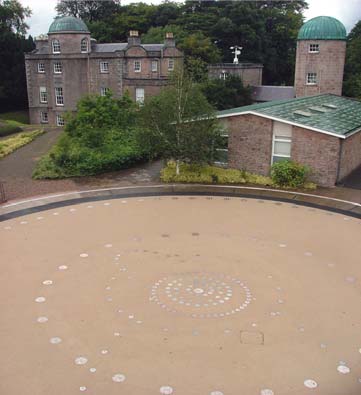| 2005 |

|
YEAR BOOK |
Armagh Observatory
|
The Armagh Observatory Human Orrery
|

The Human Orrery is simple to use and as versatile as a sundial. Many possible variations can be constructed, for example using chalk or paint on a playground or string and tent pegs on a playing field. Temporary objects, such as bright comets or spacecraft trajectories through the solar system can also be included. The key to the success of the model lies in the precision with which objects are placed on the ground.
Activities include 'Walking the Orrery' (moving around the orbits in lockstep from one disc to the next to illustrate Kepler's third law of planetary motion); identifying which planets are visible tonight (or at any other time); and discovering phenomena such as planetary alignments, conjunctions and transits. Younger users can 'Run the Orrery'; measure the distance between planets or a planet's speed in different parts of its orbit; or use the open space to create an innovative 'dance of the planets'. Advanced users can discover Kepler's laws by direct measurement and investigate subjects such as modular arithmetic, the properties of conic sections, and calendrical concepts such as leap years and the need for the Gregorian calendar reform.
For more information, see http://star. arm.ac.uk/orrery/ .
Construction of the Human Orrery was funded by the Northern Ireland Department of Culture, Arts and Leisure. Leaflets and other outreach materials have been funded by the UK Particle Physics and Astronomy Research Council.
Contact: Prof. Mark E. Bailey, Director,
Armagh Observatory,
e-mail: [email protected]